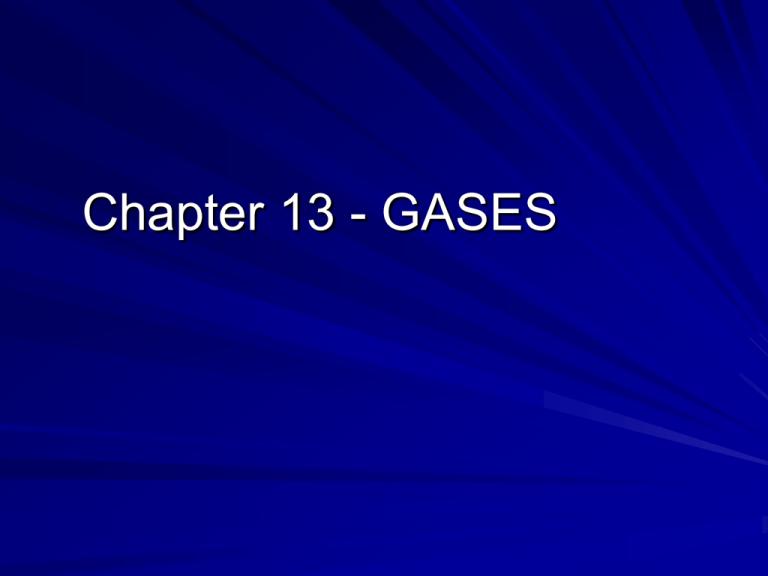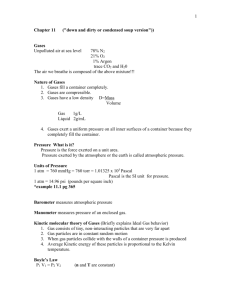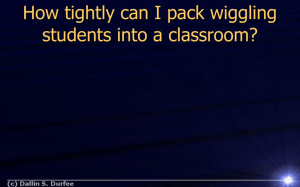Chapter 13
advertisement

Chapter 13 - GASES Properties of gases 1. are compressible 2. occupy all available volume 3. one mole of gas at 0oC and 1 atm pressure occupies 22.4 liters 4. gases have mass 5. can move (diffuse) through each other 6. gases exert pressure 7. A gases pressure depends on temperature The properties of gases are explained by the Kinetic-Molecular Theory of Gas Gases are composed of small particles that have mass. The particles are far apart (compared to the volume of the particles). They are in rapid motion and have perfectly elastic collisions The collisions of gas molecules against the sides of a container create pressure. The kinetic energy of a gas molecule is given by the equation KE = 1/2mv2 Temperature is a measure of the average KE of gas molecules. Lighter gas molecules, such as H2 move faster than heavier gas molecules (O2) if they are at the same temperature. Measuring Gas - page 424 The four variables needed to completely describe a sample of gas are the amount of gas (moles), volume, temperature and pressure. All types of gas behave the same so we do not need to know what type of molecule the gas is. Atmospheric pressure - the weight of the atmosphere pushing on us. 1 atm = 14.7 lb/in2 = 101,325 N/m2 (Pa) = 760 mm Hg 760 mm Hg corresponds to the weight per square inch that atmospheric pressure can support If mercury is 13.6 times more dense than water, what is the maximum water height that the atmosphere can support? A well any deeper than this must use a submersible pump. Start assignment (practice problems 1 & 2 page 427) Enclosed gases Absolute pressure - the true pressure of a gas (barometric pressure is an example) Gage pressure - the difference in pressure between the trapped gas and the atmosphere (tire pressure is an example). Manometer A manometer can give the true pressure of a gas by adding or subtracting the height of the Hg column from the atmospheric pressure. Draw a diagram and solve practice problems 3 and 4 on page 429. Gas Laws One mole of gas = 22.4 liters at STP (The standard temperature and pressure for gases is 0oC and 1 atm.) Boyle’s Law (pressure - volume relationship) If we have a given quantity of gas (moles) and the temperature is kept constant while the pressure and volume are changed, PV = constant (k). P1V1 = P2V2 The pressure times volume before the change is equal to the pressure times volume after the change. Do sample problem 3 page 433 Assignment continued (practice problems 5,6 page 434) Charles’s Law (temperature volume relationship) If the pressure is kept constant, the temperature and volume are directly proportional. As temperature increases, the volume also increases. Experimental volume -temperature data can be graphed and the line extended (extrapolated) to zero volume. V1T2 = V2T1 Charles’s Law Absolute temperature scale There are no negative temperatures Absolute zero is the coldest possible temp (Kelvin scale, K) - nature’s temperature scale K = oC + 273.15 As the temperature of a gas is changed, the volume of gas will be changed by a ratio of the initial and final temperature in oK. Example problem: What will be the new volume if 2 L of gas is heated from 100oC to 300oC? V1T2 = V2T1 Show how to solve sample problem 4 on page 438. Assignment continued - page 438 practice problems 7,8 Avogadro’s Law Equal volumes of gases at the same pressure and temperature will have equal number of gas particles. Three moles of gas will occupy three times the volume as one mole of gas. Dalton’s Law of Partial Pressures The sum of the partial pressures of all the components in a gas mixture is equal to the total pressure of the gas mixture. PT = pa + pb + pc + pd + - - - - Problem assignment continued (page 440 practice p. 9 & 10 THE IDEAL GAS LAW PV = nRT R = 8.314 J/(mol K) R = .0821 (atm L)/(mole K) R = 8.314 (Pa m3)/(mol K) Use the R that has the correct units for the problem Problem assignment continued page 443 practice 11, 12 Real gases Real gases can deviate from the ideal gas equation at very high pressure and at very low temperatures. This is because of the slight attractive forces between real gases. “Free-style Gas Calculations Treat every problem as a conversion problem with the ratio of the change being a correction factor. You must decide if each change will result in an increase or decrease. Example Problem: What will be 3 the new volume of 6 ft of gas if the following changes are made? 2.4 atm changed to 6.3 atm Heated from 20 oC to 300 oC 5.2 moles changed to 12.6 moles Chapter 13 assignment Chapter questions on pages 452-453 (1– 19, 23, 24) Problem Bank problems on pages 454 – 455 (27, 29, 31, 37, 39, 41, 42, 44, 52, 54) note that the answers are on page 944 You must show your work for credit.







